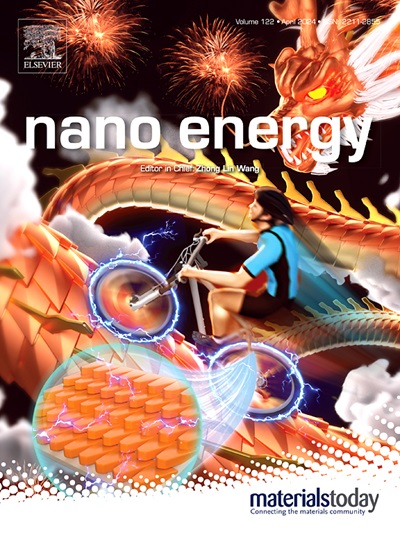Boosting Activity and Selectivity in H2O2 Electrosynthesis via Organic Motif-Mediated Intermediate Adsorption Optimization
IF 16.8
1区 材料科学
Q1 CHEMISTRY, PHYSICAL
引用次数: 0
Abstract
The two-electron oxygen reduction reaction (2e- ORR) enables sustainable H2O2 synthesis, yet its activity and selectivity are limited by the adsorption of oxygen-containing intermediates. Herein, we developed a dual-functionalized Co-based covalent organic polymers (COPs) that synergistically enhances O2 adsorption and optimizes ⁎OOH binding strength, thereby achieving concurrent breakthroughs in 2e- ORR activity and selectivity. The optimized N+-NH-CoTAPP-BDTA delivers a remarkable 97.6% H2O2 Faradaic efficiency at 200.0 mA cm-2 with a stable accumulation of 1.0 wt% H2O2. The in-situ generated H2O2 exhibits exceptional environmental remediation efficacy, achieving complete degradation of Rhodamine B (0.1 g L-1) within 60 minutes and 100% bacterial eradication (2.41 × 104 to 0 c.f.u. mL-1) in 10 minutes. Our studies reveal an intriguing synergy between -NH- and N+ motifs: -NH- motifs disrupt π-conjugation to enrich electrons and accelerate O2 activation; the N+ ionized skeletons induce localized charge deficiency, thus optimizing ⁎OOH binding strength. This dual-functionalization creates an adsorption-desorption equilibrium that simultaneously accelerate O2 activation while suppressing O-O break in ⁎OOH, thus elevating both activity and selectivity. Through rational organic motif design, we simultaneously optimized the adsorption of ⁎O2 and ⁎OOH, which establishes a paradigm for concurrently addressing the longstanding challenges of insufficient activity and selectivity in H2O2 electrosynthesis.

有机基序介导的中间体吸附优化提高H2O2电合成活性和选择性
双电子氧还原反应(2e- ORR)可以持续合成H2O2,但其活性和选择性受到含氧中间体吸附的限制。在此,我们开发了一种双功能化的co基共价有机聚合物(cop),该聚合物协同增强了O2吸附并优化了OOH结合强度,从而在2e- ORR活性和选择性方面同时取得了突破。优化后的N+-NH-CoTAPP-BDTA在200.0 mA cm-2条件下可提供97.6%的H2O2法拉第效率,稳定积累量为1.0 wt% H2O2。原位生成的H2O2表现出优异的环境修复效果,在60分钟内完全降解罗丹明B (0.1 g L-1),在10分钟内100%根除细菌(2.41 × 104至0 c.f.u. mL-1)。我们的研究揭示了- nh -基序和N+基序之间有趣的协同作用:- nh -基序破坏π共轭以富集电子并加速O2活化;N+电离骨架诱导局部电荷缺乏,从而优化了OOH结合强度。这种双功能化创造了一种吸附-解吸平衡,同时加速O2活化,抑制O-O断裂,从而提高活性和选择性。通过合理的有机基序设计,我们同时优化了对O2和OOH的吸附,这为同时解决H2O2电合成中活性和选择性不足的长期挑战建立了一个范例。
本文章由计算机程序翻译,如有差异,请以英文原文为准。
求助全文
约1分钟内获得全文
求助全文
来源期刊

Nano Energy
CHEMISTRY, PHYSICAL-NANOSCIENCE & NANOTECHNOLOGY
CiteScore
30.30
自引率
7.40%
发文量
1207
审稿时长
23 days
期刊介绍:
Nano Energy is a multidisciplinary, rapid-publication forum of original peer-reviewed contributions on the science and engineering of nanomaterials and nanodevices used in all forms of energy harvesting, conversion, storage, utilization and policy. Through its mixture of articles, reviews, communications, research news, and information on key developments, Nano Energy provides a comprehensive coverage of this exciting and dynamic field which joins nanoscience and nanotechnology with energy science. The journal is relevant to all those who are interested in nanomaterials solutions to the energy problem.
Nano Energy publishes original experimental and theoretical research on all aspects of energy-related research which utilizes nanomaterials and nanotechnology. Manuscripts of four types are considered: review articles which inform readers of the latest research and advances in energy science; rapid communications which feature exciting research breakthroughs in the field; full-length articles which report comprehensive research developments; and news and opinions which comment on topical issues or express views on the developments in related fields.
 求助内容:
求助内容: 应助结果提醒方式:
应助结果提醒方式:


